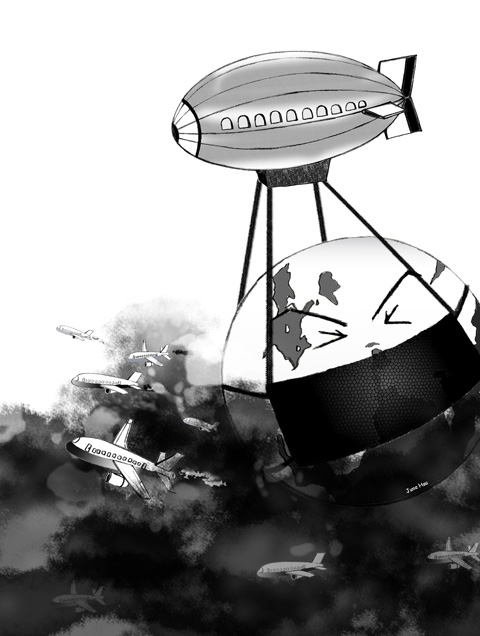Of all the charges leveled against environmentalists, perhaps the most unfair is the accusation that we are opposed to technological change. Most of the greens I know are fascinated by gadgets (sometimes to the exclusion of better solutions), while some of the people we confront seem terrified by new technologies, and react to them — witness the campaigns against windfarms — with irrational hostility.
But because environmentalists tend to have a feeling for material constraints, we recognize that solutions cannot be conjured out of thin air. In some cases they just don’t appear to exist.
There are two reasons why we make such a fuss about flying. The first is that, even as governments promise to cut emissions, everywhere airports are expanding. In the UK, the government expects the number of airline passengers to rise from 228 million in 2005 to 480 million in 2030. Before long, there will scarcely be a patch of sky without a jet in it. The other is that there are no alternative means of propelling people through the air that are not more destructive than burning ordinary aviation fuel. Or so we think.

The airline companies prescribe two cures that are even worse than the disease. Even before they are deployed commercially in jets, biofuels are spreading hunger and deforestation. At first sight, hydrogen seems more promising. If it is produced by electrolysis using renewable electricity, it’s almost carbon free. The prohibitive issue is storage. Hydrogen contains just a quarter of the energy as the same volume of jet fuel (kerosene), which means that planes could fly long distances only if they were filled with gas, rather than passengers or cargo.
This means that if hydrogen planes are to fly commercially, they need much wider bodies than ordinary jetliners. The Royal Commission on Environmental Pollution says that “the combination of larger drag and lower weight would require flight at higher altitudes” than planes fueled by kerosene.
A technology that is green at ground level becomes an environmental disaster in the stratosphere. Hydrogen’s great advantage — that it produces only water when it burns — turns into a major liability: in the stratosphere, water vapor is a powerful greenhouse gas. The commission estimates that hydrogen planes would exert a climate-changing effect “some 13 times larger than for a standard kerosene-fuelled subsonic aircraft.”
But there is another use for this gas, though I am aware that it will go down like a lead balloon with most of my readers. The word airship elicits a fixed reaction in almost everyone who hears it: “What about the Hindenburg?”
It’s as if, every time someone proposed traveling on a cruise ship, you were to ask: “But what about the Titanic?”
Yes, there was a spectacular disaster — 71 years ago. It has lodged in our minds because, like the Titanic, the Hindenburg was bigger and plusher than any craft built before it, and it was carrying rich and prominent people. The conflagration was witnessed by journalists and broadcast all over the world. It also became the technology’s funeral pyre: the Hindenburg was doomed long before it burnt, as airships were already being displaced by airplanes.
Though the designs have changed, their disadvantages have not disappeared. While a large commercial airliner cruises at about 900kph, the maximum speed of an airship is roughly 150kph. At an average speed of 130kph, the journey from London to New York would take 43 hours. Airships are more sensitive to wind than airplanes, which means that flights are more likely to be delayed. But they have one major advantage: The environmental cost could be reduced to almost zero.
Even when burning fossil fuels, the total climate-changing impact of an airship, according to researchers at the Tyndall Centre for Climate Change Research in southeast England, is 80 percent to 90 percent smaller than that of ordinary aircraft. But the airship is also the only form of transport that can easily store hydrogen: You could inflate a hydrogen bladder inside the helium balloon.
There might be a neat synergy here: one of the problems with airships is that they become lighter, and therefore harder to control, as the fuel is consumed. In this case they become heavier. Michael Stewart of the company World SkyCat suggests burning both gaseous and liquid hydrogen to keep the weight of the craft constant.
Airships fly much lower than planes, typically at about 1,300m, which means their emissions of water vapor have very little effect on temperature. If they were powered by hydrogen fuel cells, they would be almost silent, greatly reducing the effects for people on the ground. Though they are much slower than jets, the cabin can be built much wider, which means that traveling by airship would be rather like traveling by cruise ship, but at twice the speed and using a fraction of the fuel.
There are four small companies trying to get airships off the ground. Most of the new designs make use of aerodynamic lift as well as buoyancy (they are shaped like fat planes with stubby wings or tails), which means they are heavier and more stable than the old dirigibles and can land without help on the ground. They can alight on and take off from almost any flattish surface, including water. But all of them have a problem with flotation — of the financial rather than the physical kind. While the price of carbon stays low, companies have no financial incentive to switch to a different form of transport.
The only help governments are prepared to provide is development funds for military applications: raising money for killing people is always easier than raising money to save them. For a few years the Pentagon took an interest in craft that could land anywhere and carry several hundred tonnes of equipment. Otherwise, like so many other promising green technologies, this proposal is losing height in a hostile market.
All the companies promoting large commercial airships are concentrating on freight, especially in places that are poorly served by roads. The danger here is that, if they take off, they could displace not jet transport but freight shipping — in which case, if they burn diesel, they are likely to cause a net increase in carbon pollution.
Paradoxically, the other major constraint could be an environmental one. Airships are one of several green technologies that might be killed by a shortage of materials. A new generation of solar panels relies on gallium and indium, whose global supplies appear close to exhaustion. The price of platinum, which is used in catalytic converters, has tripled over the past five years. Beyond a few natural gasfields in Texas, economically viable supplies of helium are rare; even there they might be exhausted in 50 years at current rates of use, or much faster if airships take off. If there is a God, he isn’t green.
Is this proposal just a flight of fancy? Because airships feature in no official document, because they have not been considered by either government or major industry, I have no way of knowing. But like most greens I’m prepared to try almost anything, as long as it works. Can the same be said of our opponents?
In an article published on this page on Tuesday, Kaohsiung-based journalist Julien Oeuillet wrote that “legions of people worldwide would care if a disaster occurred in South Korea or Japan, but the same people would not bat an eyelid if Taiwan disappeared.” That is quite a statement. We are constantly reading about the importance of Taiwan Semiconductor Manufacturing Co (TSMC), hailed in Taiwan as the nation’s “silicon shield” protecting it from hostile foreign forces such as the Chinese Communist Party (CCP), and so crucial to the global supply chain for semiconductors that its loss would cost the global economy US$1
Concerns that the US might abandon Taiwan are often overstated. While US President Donald Trump’s handling of Ukraine raised unease in Taiwan, it is crucial to recognize that Taiwan is not Ukraine. Under Trump, the US views Ukraine largely as a European problem, whereas the Indo-Pacific region remains its primary geopolitical focus. Taipei holds immense strategic value for Washington and is unlikely to be treated as a bargaining chip in US-China relations. Trump’s vision of “making America great again” would be directly undermined by any move to abandon Taiwan. Despite the rhetoric of “America First,” the Trump administration understands the necessity of

US President Donald Trump’s challenge to domestic American economic-political priorities, and abroad to the global balance of power, are not a threat to the security of Taiwan. Trump’s success can go far to contain the real threat — the Chinese Communist Party’s (CCP) surge to hegemony — while offering expanded defensive opportunities for Taiwan. In a stunning affirmation of the CCP policy of “forceful reunification,” an obscene euphemism for the invasion of Taiwan and the destruction of its democracy, on March 13, 2024, the People’s Liberation Army’s (PLA) used Chinese social media platforms to show the first-time linkage of three new
Sasha B. Chhabra’s column (“Michelle Yeoh should no longer be welcome,” March 26, page 8) lamented an Instagram post by renowned actress Michelle Yeoh (楊紫瓊) about her recent visit to “Taipei, China.” It is Chhabra’s opinion that, in response to parroting Beijing’s propaganda about the status of Taiwan, Yeoh should be banned from entering this nation and her films cut off from funding by government-backed agencies, as well as disqualified from competing in the Golden Horse Awards. She and other celebrities, he wrote, must be made to understand “that there are consequences for their actions if they become political pawns of